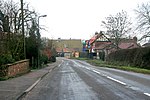Westby, Lincolnshire
Hamlets in LincolnshireLincolnshire geography stubsSouth Kesteven DistrictUse British English from November 2014

Westby is a hamlet in the civil parish of Bitchfield and Bassingthorpe, in the South Kesteven district of Lincolnshire, England. It is situated approximately 6 miles (9.7 km) south-east from the town of Grantham. Westby is considered a shrunken medieval village and at the time of Domesday Book of 1086 it consisted of eleven households.
Excerpt from the Wikipedia article Westby, Lincolnshire (License: CC BY-SA 3.0, Authors, Images).Westby, Lincolnshire
South Kesteven Bitchfield and Bassingthorpe
Geographical coordinates (GPS) Address Nearby Places Show on map
Geographical coordinates (GPS)
| Latitude | Longitude |
|---|---|
| N 52.843505 ° | E -0.556855 ° |
Address
NG33 4EA South Kesteven, Bitchfield and Bassingthorpe
England, United Kingdom
Open on Google Maps









